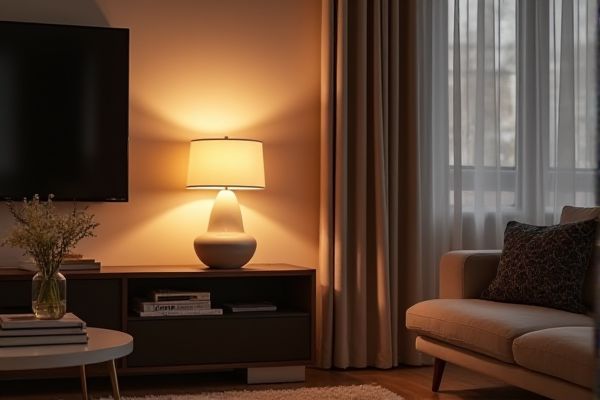
Over table lighting provides focused illumination directly above workspaces, enhancing visibility and creating a cozy ambiance ideal for dining or tasks. Wall lighting offers versatile placement options that add aesthetic appeal and ambient light without occupying table space; explore the rest of the article to discover which option best suits Your needs.
Table of Comparison
| Feature | Over Table Lighting | Wall Lighting |
|---|---|---|
| Primary Use | Illuminates dining or work tables directly for focused tasks | Enhances ambient or accent lighting along walls |
| Installation | Ceiling-mounted fixtures such as pendants or chandeliers | Mounted on vertical wall surfaces, including sconces and floodlights |
| Light Direction | Downward focused light for task clarity | Varies: uplight, downlight, or diffused for ambiance |
| Space Impact | Defines and centers the table area visually | Broadens perceived room dimensions with wall illumination |
| Design Style | Often a focal decorative piece; style impacts room's centerpiece | Subtle or decorative, complementing room aesthetics without dominating |
| Energy Efficiency | Depends on bulb type; LED options reduce consumption | Similar efficiency potential; often used for continuous ambient light |
| Maintenance | Accessible but may require ladder for replacement or adjustment | Usually easier to access for bulbs replacement and cleaning |
| Common Applications | Dining rooms, kitchens, study areas | Hallways, living rooms, bedrooms for mood or accent lighting |
Introduction to Over Table Lighting vs Wall Lighting
Over table lighting offers focused illumination directly above surfaces, enhancing tasks such as dining or working with clear, concentrated light. Wall lighting provides ambient or accent lighting, creating atmosphere and highlighting architectural features while saving space. Choosing between over table and wall lighting depends on functional needs, room layout, and desired aesthetic effects.
Key Differences Between Over Table and Wall Lighting
Over table lighting provides direct illumination focused on the tabletop area, enhancing visibility and creating a concentrated light source for tasks such as dining or working. Wall lighting, or wall sconces, offers ambient or accent lighting that enhances room atmosphere and frees up table space by being mounted on walls. The primary difference lies in functional intent: over table lighting emphasizes task-specific brightness, while wall lighting prioritizes ambient illumination and design aesthetics.
Benefits of Over Table Lighting
Over table lighting enhances task visibility and creates a focused illumination directly on dining or work surfaces, improving functionality and comfort. It adds aesthetic appeal by highlighting table settings and can serve as a centerpiece that complements interior design styles. Over table lighting also reduces shadows and glare compared to wall lighting, promoting a more pleasant and effective lighting environment.
Advantages of Wall Lighting
Wall lighting offers increased spatial efficiency by freeing up table surfaces, ideal for smaller rooms or minimalist designs. It provides targeted illumination that enhances ambiance while reducing glare, improving visual comfort for your activities. Wall lighting fixtures also add architectural interest and can serve as decorative elements, blending functionality with style seamlessly.
Ideal Spaces for Over Table Lighting
Over table lighting is ideal for dining rooms, kitchen islands, and conference tables where focused illumination enhances visibility and ambiance. It creates a centralized light source perfect for tasks such as eating, reading, or working, while also serving as a decorative element that defines the space. This type of lighting ensures balanced brightness, reducing shadows and providing a warm, inviting atmosphere.
Best Applications for Wall Lighting
Wall lighting excels in creating ambient and accent lighting in narrow hallways, stairwells, and small rooms where overhead fixtures might be impractical. These fixtures are ideal for highlighting artwork, architectural features, or providing soft, indirect illumination that enhances the atmosphere without overwhelming the space. Wall lighting also serves functional roles in outdoor settings, such as illuminating pathways and entryways while maintaining aesthetic appeal.
Design Considerations: Over Table vs Wall Lighting
Over table lighting typically requires careful attention to fixture height and brightness to avoid glare while providing focused illumination for tasks or dining. Wall lighting demands strategic placement to create ambient effects, enhance room architecture, and complement other light sources without overwhelming the space. Your design choice should balance functionality with aesthetic impact, considering how each option influences room size perception and mood.
Energy Efficiency Comparison
Over table lighting typically consumes more energy due to larger fixtures and higher wattage bulbs needed for direct illumination. Wall lighting often offers energy efficiency advantages by using lower wattage bulbs or LED modules positioned to spread light indirectly, reducing overall power consumption. Your choice between these options can significantly impact energy use, making wall lighting a preferable solution for conserving electricity in many settings.
Popular Fixtures and Styles
Popular fixtures for over table lighting include pendant lights, chandeliers, and linear suspension lights, which provide focused illumination and enhance dining or workspace ambiance. Wall lighting features sconces, wall lamps, and picture lights that add layered lighting, accentuate decor, and save floor space. Your choice depends on the room's function, style preference, and the desired balance between direct and ambient light.
Choosing the Right Lighting Solution for Your Space
Over table lighting provides direct, focused illumination ideal for dining areas or workspaces, enhancing visibility and creating a cozy ambiance. Wall lighting offers flexible, ambient light that can highlight architectural features, save floor space, and add depth to rooms with limited ceiling access. Selecting between these options depends on room size, function, and desired atmosphere to optimize both aesthetics and practicality.
 homyna.com
homyna.com